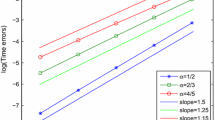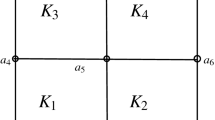Abstract
The generalized discrete Gronwall inequality is applied to analyze the optimal H1 error estimate of the time-stepping spectral method for the time-fractional diffusion equations, where the time-fractional derivative is discretized by the second-order fractional backward difference formula or the second-order generalized Newton-Gregory formula. The methodology is extended to analyze the fractional Crank–Nicolson spectral method and the time-stepping spectral method for the multi-term time-fractional differential equations. Numerical simulations are provided to support the theoretical analysis.
Similar content being viewed by others
References
Adams, R.A., Fournier, J.J.F.: Sobolev Spaces. Elsevier/Academic Press, Amsterdam (2003)
Al-Maskari, M., Karaa, S.: Numerical approximation of semilinear subdiffusion equations with nonsmooth initial data. SIAM J. Numer. Anal. 57(3), 1524–1544 (2019)
Alikhanov, A.A.: A new difference scheme for the time fractional diffusion equation. J. Comput. Phys. 280, 424–438 (2015)
Baffet, D., Hesthaven, J.S.: A kernel compression scheme for fractional differential equations. SIAM J. Numer. Anal. 55(2), 496–520 (2017)
Banjai, L., López-Fernández, M.: Efficient high order algorithms for fractional integrals and fractional differential equations. Numer. Math. 141(2), 289–317 (2019)
Bao, W., Cai, Y.: Uniform error estimates of finite difference methods for the nonlinear Schrödinger equation with wave operator. SIAM J. Numer. Anal. 50(2), 492–521 (2012)
Burrage, K., Cardone, A., D’Ambrosio, R., Paternoster, B.: Numerical solution of time fractional diffusion systems. Appl. Numer. Math. 116, 82–94 (2017)
Canuto, C., Hussaini, M.Y., Quarteroni, A., Zang, T.A.: Spectral methods. Scientific Computation. Springer, Berlin. Fundamentals in single domains (2006)
Chen, C., Thomée, V., Wahlbin, L.B.: Finite element approximation of a parabolic integro-differential equation with a weakly singular kernel. Math. Comp. 58(198), 587–602 (1992)
Chen, L., Zhang, J., Zhao, J., Cao, W., Wang, H., Zhang, J.: An accurate and efficient algorithm for the time-fractional molecular beam epitaxy model with slope selection. Comput. Phys. Commun. 245, 106–842 (2019)
Cuesta, E., Lubich, C. h., Palencia, C.: Convolution quadrature time discretization of fractional diffusion-wave equations. Math. Comp. 75 (254), 673–696 (2006)
de Carvalho-Neto, P.M., Júnior, R. F.: On the fractional version of Leibniz rule. Math. Nachr. 293, 670–700 (2020)
Diethelm, K., Ford, J.M., Ford, N.J., Weilbeer, M.: Pitfalls in fast numerical solvers for fractional differential equations. J. Comput. Appl. Math. 186(2), 482–503 (2006)
González, C., Palencia, C.: Stability of Runge-Kutta methods for abstract time-dependent parabolic problems: the Hölder case. Math. Comp. 68 (225), 73–89 (1999)
Guo, L., Zeng, F., Turner, I., Burrage, K., Karniadakis, G.E.: Efficient multistep methods for tempered fractional calculus: algorithms and simulations. SIAM J. Sci. Comput. 41(4), A2510–A2535 (2019)
Huang, C., Stynes, M.: Optimal h1 spatial convergence of a fully discrete finite element method for the time-fractional Allen-Cahn equation. Adv. Comput. Math. 46(4), 46–63 (2020)
Huang, C., Stynes, M.: Optimal spatial h1-norm analysis of a finite element method for a time-fractional diffusion equation. J. Comput. Appl. Math. 367(112), 435 (2020)
Jiang, S., Zhang, J., Zhang, Q., Zhang, Z.: Fast evaluation of the Caputo fractional derivative and its applications to fractional diffusion equations. Commun. Comput. Phys. 21(3), 650–678 (2017)
Jin, B., Li, B., Zhou, Z.: An analysis of the Crank-Nicolson method for subdiffusion. IMA J. Numer. Anal. 38(1), 518–541 (2018)
Jin, B., Li, B., Zhou, Z.: Numerical analysis of nonlinear subdiffusion equations. SIAM J. Numer. Anal. 56(1), 1–23 (2018)
Jin, B., Li, B., Zhou, Z.: Subdiffusion with a time-dependent coefficient: analysis and numerical solution. Math. Comp. 88, 2157–2186 (2019)
Jin, B., Li, B., Zhou, Z.: Subdiffusion with time-dependent coefficients: improved regularity and second-order time stepping. Numer. Math. 145, 883–913 (2020)
Le, K.N., McLean, W., Mustapha, K.: Numerical solution of the time-fractional Fokker-Planck equation with general forcing. SIAM J. Numer. Anal. 54 (3), 1763–1784 (2016)
Li, B., Sun, W.: Unconditional convergence and optimal error estimates of a Galerkin-mixed FEM for incompressible miscible flow in porous media. SIAM J. Numer. Anal. 51, 1959C–1977 (2013)
Li, B., Wang, H., Wang, J.: Well-posedness and numerical approximation of a fractional diffusion equation with a nonlinear variable order. ESAIM: Math. Model. Numer. Anal. 55, 171–207 (2021)
Li, C., Wang, Z.: The local discontinuous Galerkin finite element methods for Caputo-type partial differential equations: mathematical analysis. Appl. Numer. Math. 150, 587–606 (2020)
Li, D., Wu, C., Zhang, Z.: Linearized Galerkin FEMs for nonlinear time fractional parabolic problems with non-smooth solutions in time direction. J. Sci. Comput. 80(1), 403–419 (2019)
Liao, H.l., Li, D., Zhang, J.: Sharp error estimate of the nonuniform L1 formula for linear reaction-subdiffusion equations. SIAM J. Numer. Anal. 56(2), 1112–1133 (2018)
Liao, H.l., McLean, W., Zhang, J.: A discrete Grönwall inequality with applications to numerical schemes for subdiffusion problems. SIAM J. Numer. Anal. 57(1), 218–237 (2019)
Liao, H.l., Tang, T., Zhou, T.: A second-order and nonuniform time-stepping maximum-principle preserving scheme for time-fractional Allen-Cahn equations. J. Comput. Phys. 414(16), 109,473 (2020)
Lin, Y., Xu, C.: Finite difference/spectral approximations for the time-fractional diffusion equation. J. Comput. Phys. 225(2), 1533–1552 (2007)
Liu, Z., Li, X.: A parallel CGS block-centered finite difference method for a nonlinear time-fractional parabolic equation. Comput. Methods Appl. Mech. Engrg. 308, 330–348 (2016)
López-Fernández, M., Lubich, C., Schädle, A.: Adaptive, fast, and oblivious convolution in evolution equations with memory. SIAM J. Sci. Comput. 30(2), 1015–1037 (2008)
Lubich, C.: Discretized fractional calculus. SIAM J. Math. Anal. 17(3), 704–719 (1986)
Luchko, Y.: Initial-boundary-value problems for the one-dimensional time-fractional diffusion equation. Fract. Calc. Appl. Anal. 15, 141–160 (2012)
Lv, C., Xu, C.: Error analysis of a high order method for time-fractional diffusion equations. SIAM J. Sci. Comput. 38(5), A2699–A2724 (2016)
Ren, J., Liao, H.L., Zhang, J., Zhang, Z.: Sharp H1,-norm error estimates of two time-stepping schemes for reaction-subdiffusion problems. arXiv:1811.08059 (2018)
Stojanović, M., Gorenflo, R.: Nonlinear two-term time fractional diffusion-wave problem. Nonlinear Anal. Real World Appl. 11(5), 3512–3523 (2010)
Sun, J., Nie, D., Deng, W.: Fast algorithms for convolution quadrature of Riemann-Liouville fractional derivative. Appl. Numer. Math. 145, 384–410 (2019)
Sun, Z.Z., Wu, X.: A fully discrete difference scheme for a diffusion-wave system. Appl. Numer. Math. 56(2), 193–209 (2006)
Wang, D., Zou, J.: Dissipativity and contractivity analysis for fractional functional differential equations and their numerical approximations. SIAM J. Numer. Anal. 57(3), 1445–1470 (2019)
Wang, K., Zhou, Z.: High-order time stepping schemes for semilinear subdiffusion equations. SIAM J. Numer. Anal. 58(6), 3226–3250 (2020)
Xu, Q., Hesthaven, J.S.: Discontinuous Galerkin method for fractional convection-diffusion equations. SIAM J. Numer. Anal. 52(1), 405–423 (2014)
Yang, Y., Zeng, F.: Numerical analysis of linear and nonlinear time-fractional subdiffusion equations. Commun. Appl. Math. Comput. 1(4), 621–637 (2019)
Zeng, F., Li, C., Liu, F., Turner, I.: Numerical algorithms for time-fractional subdiffusion equation with second-order accuracy. SIAM J. Sci. Comput. 37(1), A55–A78 (2015)
Zeng, F., Turner, I., Burrage, K., Karniadakis, G.E.: A new class of semi-implicit methods with linear complexity for nonlinear fractional differential equations. SIAM J. Sci. Comput. 40(5), A2986–A3011 (2018)
Zeng, F., Zhang, Z., Karniadakis, G.E.: Second-order numerical methods for multi-term fractional differential equations: smooth and non-smooth solutions. Comput. Methods Appl. Mech. Engrg. 327(1), 478–502 (2017)
Zhang, H., Zeng, F., Jiang, X., Karniadaki, G.E.: Convergence analysis of the time-stepping numerical methods for time-fractional nonlinear subdiffusion equations. arXiv:2007.07015 (2020)
Zhu, H., Xu, C.: A fast high order method for the time-fractional diffusion equation. SIAM J. Numer. Anal. 57(6), 2829–2849 (2019)
Acknowledgements
We would like to express our gratitude to the editor for taking time to handle the manuscript and the anonymous referees’ comments that greatly improved the quality of this paper.
Funding
This work has been supported by the National Natural Science Foundation of China (Grants Nos.12001326, 11771254, 12171283, 12120101001), Natural Science Foundation of Shandong Province (Grants No. ZR2019ZD42), China Postdoctoral Science Foundation (Grant No. BX20190191, 2020M672038), and Start Up Fund Support of Shandong University (Grant No. 11140082063130).
Author information
Authors and Affiliations
Corresponding author
Ethics declarations
Conflict of interest
The authors declare no competing interests.
Additional information
Communicated by: Bangti Jin
Publisher’s note
Springer Nature remains neutral with regard to jurisdictional claims in published maps and institutional affiliations.
Appendices
A Appendix
A Proof of \(d^{\varepsilon }_{n}\geq 0\) for FBDF-2
Proof
It is very easy to obtain b(α)(z) = (3/2 − z/2)α and \(b^{(\alpha )}_{n}=b^{(\alpha )}_{0}3^{-n}{a}^{(\alpha )}_{n}\), where \(a^{(\alpha )}_{n}=\frac {{\varGamma }(n+\alpha )}{{\varGamma }(\alpha ){\varGamma }(n+1)}\), \(b^{(\alpha )}_{0} = ({3}/{2})^{\alpha }\), and
Then, \(d^{\varepsilon }_{n}\) can be expressed by
Using \({a}^{(\alpha )}_{j}\leq 0\) and (??), we have
Combining (2)–(3) and choosing \(\varepsilon =\frac {2}{3}b^{(\alpha )}_{0}=(3/2)^{\alpha -1}\) yields
The proof is complete. □
B Proof of \(d^{\varepsilon }_{n}\geq 0\) for GNGF-2
Proof
For the GNGF-2, we have \(b^{(\alpha )}_{0}=1+\alpha /2,b^{(\alpha )}_{1}=-\alpha /2\), \(b^{(\alpha )}_{n}=0\) for n > 1, and B0 = 1.
Letting ε = 1/2 yields \(d^{\varepsilon }_{0}=1/2+b^{(\alpha )}_{0}=(3+\alpha )/2>0\). For n ≥ 1, we have
where \(\frac {{a}^{(-\alpha )}_{n}}{{a}^{(-\alpha )}_{n-1}}=\frac {n-1+\alpha }{n}\). The proof is completed. □
Rights and permissions
About this article
Cite this article
Zhang, H., Jiang, X. & Zeng, F. An H1 convergence of the spectral method for the time-fractional non-linear diffusion equations. Adv Comput Math 47, 63 (2021). https://doi.org/10.1007/s10444-021-09892-5
Received:
Accepted:
Published:
DOI: https://doi.org/10.1007/s10444-021-09892-5
Keywords
- Time-fractional non-linear diffusion equations
- The discrete fractional Gronwall inequality
- Spectral method
- Multi-term time-fractional differential equations




